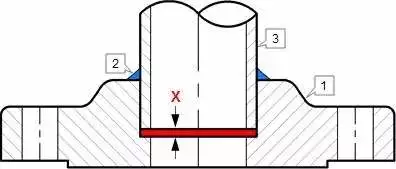The Differences between Socket Welding and Butt Welding
Posted: 11/14/2017 09:40:07 Hits: 614
Socket Welding
Socket welding, just as its name implies, is socket welding in the pipeline which forms angle welding.

1. Socket welded flanges 2. Welding seams 3. Pipelines X equals gaps of welding seams
Socket welding is usually used for welding pipes with small diameters. The common specifications are diameters smaller than DN50, and the greatest diameter of the standard is DN100 or 4 inches. This kind of welding is simple and quick, while it is difficult to operate butt welding for pipes with small specifications. The non-destructive testing methods for socket welding are magnetic particle testing and penetrant testing. Magnetic particle testing is used for carbon steel parts and penetrant testing is used for stainless steel parts. Socket welding components are generally socket flanges, socket elbows, socket tees, socket caps, etc.
Butt welding
Butt welding is the corresponding welding of pipe fittings and pipe fittings, pipe fittings and flanges or pipe fittings and pipes whose diameters are the same. Of course, the corresponding pipe ends are beveled ends.

1. But welded flanges 2. Welding seams 3. Pipes or pipe fittings
This kind of welding is the most commonly used welding for pipe connection, and it has high strength. The testing method of butt welding is 100% ray inspection. The common parts are steel pipes, butt welding valves, butt welding flanges, butt welding tees, butt welding elbows and butt welding reducers.
The differences between socket welding and butt welding
1. Diameters
Socket welding can be used for pipes with small diameters, and it is generally applied to pipes or pipe fittings whose diameters are less than DN50.
Butt welding is widely used for pipes with big and small diameters, and threaded welding or socket welding is used for pipes with small diameters.
2. Ends
Usually, there should be a beveled end from 30 to 37.5° for butt welding in order to fill the welding bead. Of course, there will be a compound beveled end for super thick walls.
Socket welding doesn't require a bevel, and it can directly weld the part.
3. Welding seams
Socket welding seams are fillet welding seams.
Butt welding seams are butt welding seams, and the requirement for butt welding is high.
4. Non-destructive testing
The non-destructive testing methods for socket welding are magnetic particle testing and penetrant testing. Penetrant testing is used for stainless steel parts and magnetic particle testing is used for carbon steel parts. The testing method of butt welding is 100% ray inspection.
Socket welding, just as its name implies, is socket welding in the pipeline which forms angle welding.

1. Socket welded flanges 2. Welding seams 3. Pipelines X equals gaps of welding seams
Socket welding is usually used for welding pipes with small diameters. The common specifications are diameters smaller than DN50, and the greatest diameter of the standard is DN100 or 4 inches. This kind of welding is simple and quick, while it is difficult to operate butt welding for pipes with small specifications. The non-destructive testing methods for socket welding are magnetic particle testing and penetrant testing. Magnetic particle testing is used for carbon steel parts and penetrant testing is used for stainless steel parts. Socket welding components are generally socket flanges, socket elbows, socket tees, socket caps, etc.
Butt welding
Butt welding is the corresponding welding of pipe fittings and pipe fittings, pipe fittings and flanges or pipe fittings and pipes whose diameters are the same. Of course, the corresponding pipe ends are beveled ends.

1. But welded flanges 2. Welding seams 3. Pipes or pipe fittings
This kind of welding is the most commonly used welding for pipe connection, and it has high strength. The testing method of butt welding is 100% ray inspection. The common parts are steel pipes, butt welding valves, butt welding flanges, butt welding tees, butt welding elbows and butt welding reducers.
The differences between socket welding and butt welding
1. Diameters
Socket welding can be used for pipes with small diameters, and it is generally applied to pipes or pipe fittings whose diameters are less than DN50.
Butt welding is widely used for pipes with big and small diameters, and threaded welding or socket welding is used for pipes with small diameters.
2. Ends
Usually, there should be a beveled end from 30 to 37.5° for butt welding in order to fill the welding bead. Of course, there will be a compound beveled end for super thick walls.
Socket welding doesn't require a bevel, and it can directly weld the part.
3. Welding seams
Socket welding seams are fillet welding seams.
Butt welding seams are butt welding seams, and the requirement for butt welding is high.
4. Non-destructive testing
The non-destructive testing methods for socket welding are magnetic particle testing and penetrant testing. Penetrant testing is used for stainless steel parts and magnetic particle testing is used for carbon steel parts. The testing method of butt welding is 100% ray inspection.
Post URL: https://www.landeepipefitting.com/the-differences-between-socket-welding-and-butt-welding.html
Landee is a professional industrial pipe fitting manufacturer and be well accepted by customers all over the world, we has been producing Pipe Fitting for a variety of applications since 1985. welcome to access our website: https://www.landeepipefitting.com.
